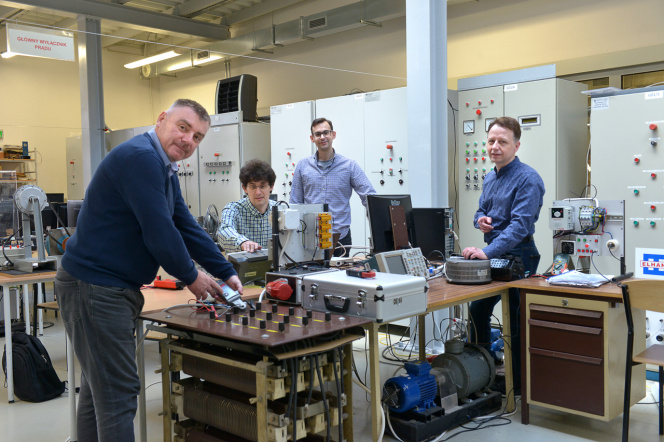Date added: 2022-05-23
Five phases and no permanent magnets. A new type of generator has been developed at Gdańsk Tech

A team of scientists from WEiA, led by Roland Ryndzionek, PhD, composed of: Krzysztof Blecharz, PhD Eng., Filip Kutt, PhD Eng., Grzegorz Kostro, PhD Eng. and Michał Michna, PhD Eng., developed a prototype of a new five-phase generator. It is a multi-phase induction generator for application in a wind, water or gas power plants. It can also be utilized by the military and e.g. in tanks or armored cars. Using five-phase control winding in the prototype is innovative.
– Three-phase generators are widely available on the market, but there are no machines with a five-phase control winding. We are pioneers in this field - emphasizes Grzegorz Kostro - So far, such a prototype has not been developed yet, because it is problematic to develop such control winding that will not be coupled with the power winding directly, but through a shorted rotor winding and to attach a dedicated control system to it. We did it.
Alternating current machines, such as this generator, need a rotating magnetic field to function properly. In order to generate this type of magnetic field in a stationary system the windings need to be appropriately distributed (where there are at least 2 phases). Loss of power in one of the phases of two-phase or three-phase windings immediately disqualifies the operation of the entire system, as it is then impossible to obtain a rotating magnetic field. The five phases in the control winding mean that the generator can continue to work when one of the phases fails, or when one leg of the inverter is damaged. This results in increased reliability of the generator and ensures greater safety - adds Filip Kutt.
– Due to five phases, our generator will continue to work in an emergency, at a slightly reduced output power by 10-15 percent, however strong enough for the device it powers not to stop working until the defect is repaired - explains Michał Michna – It should be noted that we are the only team that undertook the construction of such a prototype in Poland. We have also not met with such research in the world.
The team has already prepared a prototype of a five-phase brushed generator and is currently working on a brushless model.
– Currently, we are facing an energy crisis and one of the possibilities of diversifying energy sources is to obtain it as often as possible from ecological sources, for example wind farms. Not only does our generator guarantee increased reliability, but it is also ecological. We do not use permanent magnets for its construction, which are commonly used in other devices of this type. It is problematic to obtain them on a mass scale, because the magnet market has been completely monopolized by China. Thanks to our idea, we can become independent from Asian markets. Devices without permanent magnets are extremely desirable, therefore we are sure that our generator will attract interest, especially on the European market - says Roland Ryndzionek.
– In order to gain full advantage of the properties and capabilities of the developed model of a multi-phase generator, it is necessary to use a dedicated power electronic converter solution, which is not available on the market. The solution proposed by our team is modern not only in terms of generator design, but also in terms of the applied topology of the bidirectional voltage converter. The internal configuration of the converter uses DC voltage intermediate circuits to connect a standard three-phase inverter from the supply network side and a five-phase inverter from the generator rotor. The converter model developed and constructed in this way enables application of the latest control strategies for generator power control in regular operation and in the event of failure of the five-phase inverter transistors. Works in the field of applied power electronics solutions and the development of control systems constitute an additional challenge for us - emphasizes Krzysztof Blecharz.
Project completion is scheduled for October this year. Next step might involve commercialization of the invention.

Project title: “Design and development of a multiphase Brushless Doubly-Fed Induction Generator” conducted within the Argentum Triggering Research Grants program.
Grant: PLN 299 521
Project conducted as part of EkoTech Center

